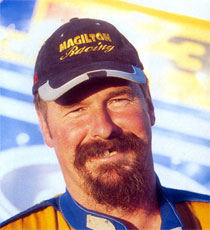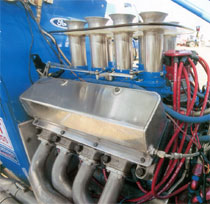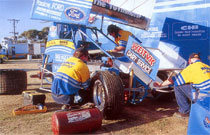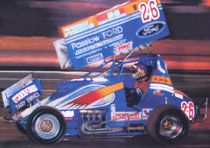Against the Grain
| Madman Magilton shakes up the Chev-filled Sprintcar field with Clevo clout – a lone Ford tying their bows in knots |
| Courtesy of Street Machine Magazine | Story: Craig Parker Photos: Mark Arblaster |
You’d think Sprint car racing is a restricted category that mandates the use of a control engine. Everywhere you look it’s Chev, Chev, Chev. Until you spot the Ford banner flying proudly atop Victorian David Magilton’s transporter. Dave’s a Tim boon dairy farmer who milks cows Monday to Friday so he can race Saturday and Sunday.
“I’m a Ford man through and through, and there was no way I was going to get a cut-and-tuck and put a Chev in it,” chuckles David. “Before racing sprinters I ran super rods, a class that requires competitors to run a factory production engine. And a stock 351 4V Cleveland is a far better package than any stock 350 Chev – it accelerated so much harder. Then two years ago, when I stepped up to sprinters, I saw no reason to change. Besides, I’ve gained a lot of exposure from campaigning a Ford, as I’m affectionately known everywhere as the Ford Guy. That’s a bloody good thing in a sport in which it’s hard to gain recognition. Better still, I get to bag out all the Chevy guys, something they can’t do to each other!”
Truth be known, David’s winged warrior is the only Ford-powered Sprint car down under. He thinks it’s the only Clevo powered sprinter in the world, as all the US Ford runners use lighter Windsor-based engine.
“When I told people I wanted to build a Ford for my sprinter, most of them thought I was nuts and just laughed at me,” says David. But Johnny from Vogels -Motors (with much advice from John Sidney Race Engines) could see the potential and decided to take on the project. First up they unearthed a rare-as-rocking-horse-shit, virgin 2V, two-bolt block, which copped an oil restrictor kit, then was converted to accept four-bolt billet mains caps before being bored out to 4.030 inches. This makes 358 cubes when combined with the 3.5-inch billet crank from Crankshaft Rebuilders.
Carrillo steel rods hook up to the 13.5:1 Ross forged pistons, and a four-stage Peterson dry-sump system circulates the lubrication. A KSE water pump and Griffin aluminium radiator look after cooling duties. Up the middle there’s an Isky roller cam operating standard-ratio (1.73:1) Crane rockers, Isky Gold Stripe valve springs and 2.1 9 and 1. 71 Ferrea valves.
After a heavily modified set of factory iron 4V heads called it quits under the strain, Dave opted for Aussie-made alloy units from Cylinder Head Innovations (CHI). PRE Race Engines supplied and prepared the CHI heads, which were an easy choice as they bolted up to the existing, expensive valve train and exhaust manifolding. And they turned out to be the highest flowing heads – bar none – PRE had ever done.
A Mallory Mag III magneto lights the fire, while Fel-Pro O-ring head gaskets seal it. Topping the impressive combination is a Hilborn 2 3/16 mechanical injection system squirting pure methanol.
It’s good for 750 ponies and 58Oftlb. That’s damn impressive – whoever said alcohol and cars don’t mix got it all wrong! A unique feature of Sprint car engines is they don’t run any accessory drive belts. This created a mountain of headaches for Dave. The Chevy guys can buy everything off the shelf, but Dave’s had to design and build from scratch a number of components like the front timing case cover, engine mounts and cam drives along with the power steering, water, and dry-sump pump drives.
Is the car competitive? Currently it’s a bit overweight – a slightly rounded Dave thought about dieting or chopping a leg off but eventually dismissed both ideas. Nevertheless, with the old iron heads, he flew to second place in the 360-cube class, and scored Rookie of the Year in both 360 and 372 divisions. E3ofting up the alloy heads immediately bumped the car up into the open class, where bigger injection, 372-cube limits and alloy blocks put David’s sprinter around 45kg and 100hp behind the leaders. Things will be different next season as there’s a new Nathan McDonald Cheetah chassis on the way, and an all-alloy Fontana engine. This combo should give the Ford Guy the goods to push number V26 back up to the pointy end of the field.
The scariest moment David’s had in the car is when he got the car up at about 45 degrees on the back right-hand wheel. Nobody caught the moment on film, but Dave caught it in his jocks, which are framed up on the wall at home to remind him of the occasion.
Devoted wife Melissa is not only head crew chief (she’s got a calmer head than crew members Duncan and Peter), but is also a sign writer by trade and is responsible for the car’s livery. David jovially admits that Melissa has bought all his race cars for him, too!
You’ve got to be a bit left of field to run a Ford in such a Chevrolet dominated arena, and Team Magilton definitely fits into this category as their fridge is always fully stocked (strictly for after-race consumption) and they have garnered themselves a hard-earned reputation around their home tracks of Avalon and Warrnambool for partying. So next time you’re at the speedway and spot the Ford flags, go say g’day to the Ford guy.
 |
Timboon local David Magilton
 |
Rare sight in Spintcar Bays – Ford power, all 750hp of it
 |
Team Magilton – wife Mellissa, and crew Duncan and Pete get stuck in with preparing the between rounds
 |
If you think sprint cars are a bit agricultural, consider this; many of the big budget teams run as light as 580kg with over 750 horses. That’s a power-to-weight ratio approaching current Formula One cars. And as for down force, those little beasts are pinned down by a force equivalent to a modern F1 car. Yep, sprinters are one hell of a wild ride. It’s flat to the floor for 10-to 11-second quarter miles with four turns in between. Yeeha!

